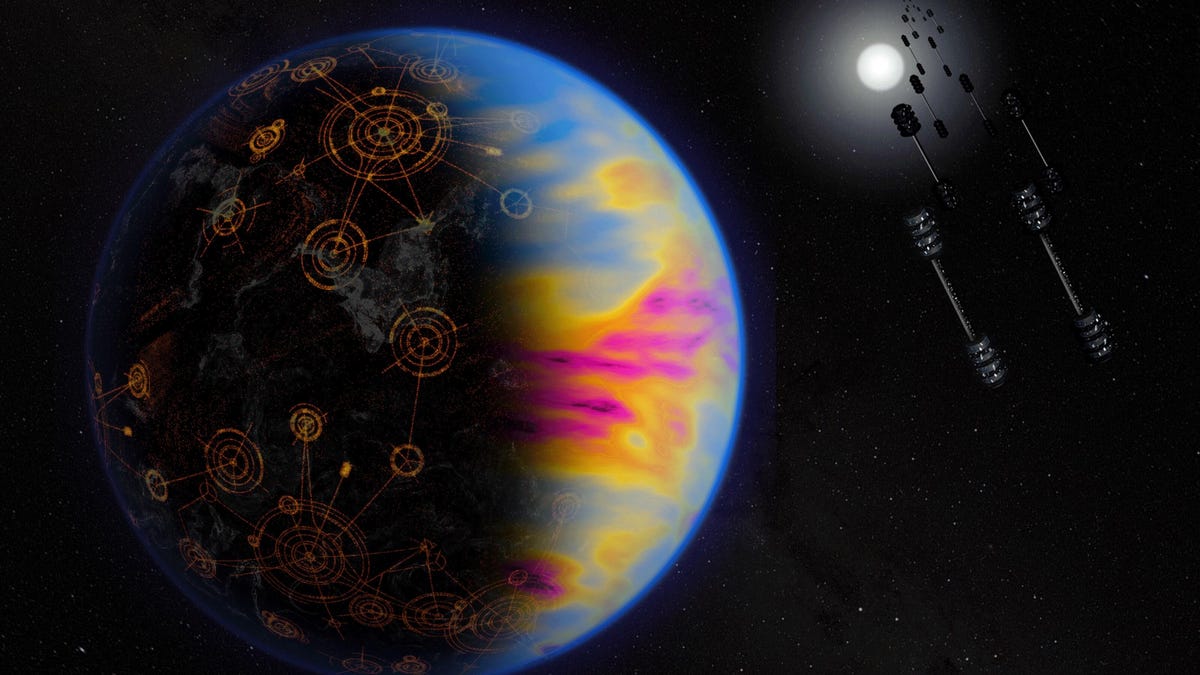NASA says we should search for aliens by looking for their pollution
New research funded by the space agency suggests next-generation telescopes might be able to see the emissions of far-flung smokestacks.

In this artist's illustration, the colors of an exoplanet are exaggerated to show industrial pollution, which otherwise isn't visible.
We know the galaxy is home to plenty of potentially habitable exoplanets, but to determine whether anything is actually living on these worlds scientists hope to spot some sign of life, a so-called biosignature or technosignature. New research out of NASA's Goddard Space Flight Center in Maryland suggests searching for alien pollution as one such indicator.
"Observing NO2 (nitrogen dioxide) on a habitable planet could potentially indicate the presence of an industrialized civilization," Goddard's Ravi Kopparapu explained in a statement. "On Earth, most of the nitrogen dioxide is emitted from human activity -- combustion processes such as vehicle emissions and fossil-fueled power plants."
Kopparapu is lead author of a study that investigates the notion of NO2 as a potential technosignature on planets beyond our solar system. The paper will be published in a forthcoming edition of the Astrophysical Journal.
Other scientists have considered chlorofluorocarbons (CFCs) as a possible sign of industrial activity beyond Earth. They've been used on Earth as refrigerants but have been phased out because of their adverse effects on the ozone layer. Study co-author Jacob Haqq-Misra from the Blue Marble Institute of Science in Seattle notes that CFCs could also be used to terraform and warm the atmosphere of a planet like Mars to make it more habitable.
"As far as we know, CFCs are not produced by biology at all, so they are a more obvious technosignature than NO2," Haqq-Misra said. "However, CFCs are very specific manufactured chemicals that might not be prevalent elsewhere; NO2, by comparison, is a general byproduct of any combustion process."
The problem is that NO2 can also be produced through natural processes like volcanoes and lightning. This means any observation of NO2 could be a false positive for life. Co-author Giada Arney of NASA Goddard explains that a detection would need to be run through models that estimate the maximum amount of NO2 an alien world could have from natural sources.
"If we observe more NO2 than our models suggest is plausible from non-industrial sources, then the rest of the NO2 might be attributed to industrial activity, " Arney said. "Yet there is always a possibility of a false positive in the search for life beyond Earth, and future work will be needed to ensure confidence in distinguishing true positives from false positives."
It's also possible that clouds and aerosols in a planet's atmosphere could be confused with the signature of NO2.
So looking for pollution on another world will require more advanced computer models to help filter out all these potential false positives. It will also require hundreds of hours of observing on a future large telescope, a substantial but not unprecedented amount of time.
Fortunately, a new generation of big telescopes, such as NASA's James Webb Space Telescope, are set to see first light in the coming years. Perhaps some of their first assignments will be to search for alien smog.
Follow CNET's 2021 Space Calendar to stay up to date with all the latest space news this year. You can even add it to your own Google Calendar.

